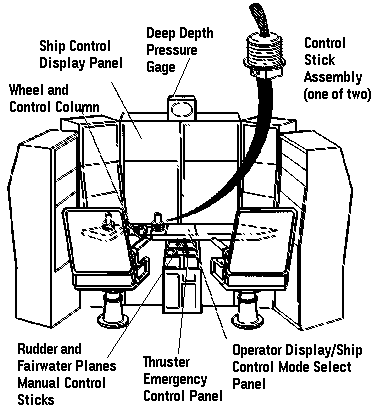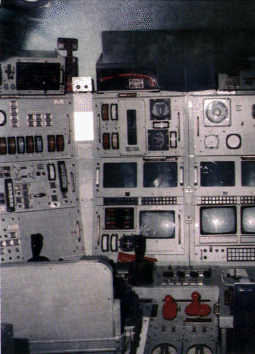The NR-1 Submarine
NR-1 has three systems for producing depth and course changes in addition to compressed air de-ballasting and emergency jettisoning systems. The three normal control systems are :
 Normal surfacing is achieved by use of the planes and main
propulsion power, pumping of variable ballast water, and
blowing down main ballast water when near or on the surface.
Normal surfacing is achieved by use of the planes and main
propulsion power, pumping of variable ballast water, and
blowing down main ballast water when near or on the surface.
The steering and diving system functions conventionally
except that only the diving planes on the bridge fairwater are
used for depth changing, while the stern stabilizers remain
fixed. NA-1 has balanced lower and upper rudders on a
common stock. The control surfaces are powered from the
ship's internal hydraulic system. At full speed the submarine's
turning radius is about 900 ft (215 m).A sustained trim of about
1o can be achieved by use of the diving planes alone. The
rudder and planes have decreasing effect as ship speed
decreases, becoming generally ineffective below 2 knots.
 The ship control station provides means for manual,
automatic, or emergency control of all thrusters and steering
and diving surfaces. The ship is normally controlled by the pilot
using the joysticks or a wheel and column control. As an
alternative to manual control, the pilot or co-pilot may lay in an
expanding square or serpentine course, and have the computer
continuously update heading commands.
The ship control station provides means for manual,
automatic, or emergency control of all thrusters and steering
and diving surfaces. The ship is normally controlled by the pilot
using the joysticks or a wheel and column control. As an
alternative to manual control, the pilot or co-pilot may lay in an
expanding square or serpentine course, and have the computer
continuously update heading commands.
The thrusters are used for ship control at speeds slower than
2 knots. Each of the forward and after free flooding spaces has
two 7 hp (5.2 kw) thrusters in an X-arrangement, consisting of a
24 in (60 cm) diameter duct with a submersible motor-driven
impeller. Each thruster can be controlled from 0 to 300 lb (136
kg) of thrust. Using the thrusters, the ship can be pitched To, or
turned in its own length. Using the thrusters in combination with
main propulsion power, the ship can be "crabbed" over the
ocean bottom in side currents, while tracking straight on the
bottom. The thrusters will keep the ship's position in a 1/4 knot
broadside current, as is desirable for following submarine cables
or pipelines. The thrusters can be proportionally controlled, or
operated at full power in an emergency, from joysticks at the
control station.
A pumped water variable ballast system provides the normal method of changing depth, and an auxiliary variable ballast system is used during special missions. The variable ballast system compensates for ship weight changes and also can take on up to 1000 lb (450 kg) of water at depth, to adjust the ship's weight on the seabed. The system is used to achieve neutral buoyancy for hovering. lt has external tankage of sufficient capacity to provide neutral buoyancy from surface to test depth, in seawater of 63.6 to 64.3 lb/cu-ft density (1.016 to 1.029 sg), which encompasses all densities that might be encountered in the open sea.
A freshwater trim system inside the pressure hull can compensate for, or induce a 15 degree trim angle under normal submerged conditions. The system consists of forward and after trim tanks connected by piping and a positive displacement pump. The trim system can change ship pitch angle at 1.7 degree/min, and is controlled from the control panel.
All NR-1 images and text courtesy of the Department of the Navy - Sea Systems Command.
![]()
![]()
JASON Project homepage ||
Teachers' Guide ||
Students' Corner ||
Search
Gene Carl Feldman
(gene@seawifs.gsfc.nasa.gov)
(301) 286-9428
Todd Carlo Viola, JASON Foundation for Education (todd@jason.org)
Revised: 17 Oct 1995